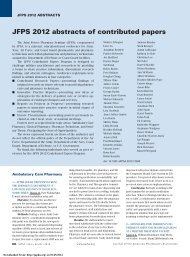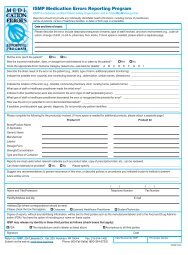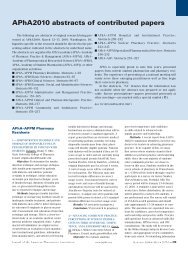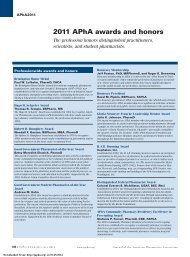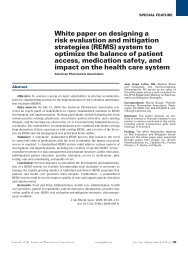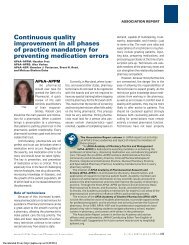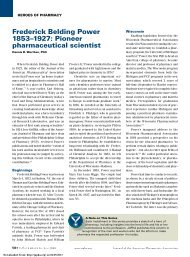Downloaded - Journal of American Pharmacists Association
Downloaded - Journal of American Pharmacists Association
Downloaded - Journal of American Pharmacists Association
You also want an ePaper? Increase the reach of your titles
YUMPU automatically turns print PDFs into web optimized ePapers that Google loves.
FEATURE Annual Meeting Abstracts 2004<br />
Conclusions: Except for physicians, sources used<br />
most frequently by women were not always considered<br />
to be the best sources <strong>of</strong> information regarding<br />
treatment <strong>of</strong> menopause.<br />
49—WORK AND COST ANALYSIS OF<br />
PHARMACEUTICAL CARE DELIVERED BY<br />
PHARMACISTS IN PRIMARY CARE CLIN-<br />
ICS. Helou L, Sorensen T, University <strong>of</strong> Minnesota.<br />
E-mail: helou002@umn.edu<br />
Objective: (1) Identify the amount <strong>of</strong> revenue<br />
generated by clinical pharmacists in primary care<br />
settings and compare this amount with the pharmacy<br />
personnel cost <strong>of</strong> service delivery and (2) model<br />
potential patient-care revenues using a resourcebased<br />
relative value scale (RBRVS) for reimbursement<br />
<strong>of</strong> pharmaceutical care.<br />
Methods: Clinical pharmacists practicing in four<br />
Minnesota primary care clinics will record workload<br />
and clinical data for patients evaluated during a 4-<br />
week period in October and November 2003. Billing<br />
in these clinics is accomplished via cash payment,<br />
“incident-to” billing, and/or institutional provider<br />
fees. Data collected will include but are not limited<br />
to: reason for pharmacist assessment, time committed<br />
to encounter, number <strong>of</strong> drugs and medical conditions<br />
reviewed during assessment, and number <strong>of</strong><br />
drug therapy problems identified. Revenue collected,<br />
as cash or from third-party payers, from each<br />
encounter will be identified and compared with<br />
workload data. Workload and clinical data collected<br />
will be used to model projected revenues using a<br />
RBRVS for pharmaceutical care reimbursement that<br />
models the RBRVS applied to medical reimbursement<br />
for medical care.<br />
Results: Results <strong>of</strong> this project will allow determination<br />
<strong>of</strong> the cost–revenue differential for the<br />
delivery <strong>of</strong> pharmaceutical care in a primary care<br />
setting. Data collected will allow for a prospective<br />
modeling <strong>of</strong> the cost–revenue differential using a<br />
RBRVS for pharmaceutical care.<br />
Conclusions: The mechanism by which pharmacists<br />
will be reimbursed for pharmaceutical care,<br />
should these services be included in Medicare insurance<br />
plans, is unknown. Reimbursement may model<br />
the RBRVS <strong>of</strong> medical provider reimbursement.<br />
This project will allow prospective evaluation <strong>of</strong> one<br />
proposed RBRVS for pharmaceutical care.<br />
50—EMERGENCY CONTRACEPTION<br />
PILLS—EDUCATING PHARMACISTS UTI-<br />
LIZING A CONTINUING EDUCATION PRO-<br />
GRAM. Morawiec K, Northeastern University,<br />
Dougherty T, Presbyterian Medical Center, Penn<br />
Family Care. E-mail: kmorawiec@hotmail.com<br />
Objective: To develop, conduct, and assess the<br />
effectiveness <strong>of</strong> an interactive, multidisciplinary<br />
continuing education (CE) program about emergency<br />
contraception pills (ECPs).<br />
Methods: A unique CE program about ECPs,<br />
practice guidelines and state/federal legislation was<br />
created for pharmacists practicing in Massachusetts.<br />
<strong>Pharmacists</strong> were invited to attend through pharmacy<br />
associations, E-mails, faxes, and site visits. A<br />
variety <strong>of</strong> learning methods were used: lecture, casebased<br />
discussions, and video-counseling sessions.<br />
Pamphlets in English and Spanish were developed<br />
and distributed to participants to facilitate patient<br />
counseling in their practice settings. The presenters<br />
panel consisted <strong>of</strong> a physician, faculty pharmacist,<br />
and assistant director for the Massachusetts Health<br />
Department family planning program. Participants<br />
completed a voluntary pretest survey to assess<br />
knowledge, medical practices, attitudes, and patient<br />
encounters. A posttest survey was mailed 3 months<br />
later. A comparison <strong>of</strong> the pretests and posttests were<br />
used to assess the program’s effectiveness.<br />
Results: The program was attended by 21 pharmacists—12<br />
community, 6 hospital, and 3 faculty<br />
pharmacists. Of 19 participants, 37% felt confident,<br />
56% felt unconfident, and 5% felt very unconfident<br />
in the accuracy <strong>of</strong> ECP information they were providing.<br />
Of the 12 community pharmacists, 67%<br />
rarely or never discussed ECPs when counseling<br />
patients receiving prescription contraceptives.<br />
Among all participants, 81% knew ECPs were most<br />
effective when used within 72 hours after unprotected<br />
sex, and 43% did not know that progestin-only<br />
ECPs are more effective than combined ECPs.<br />
Results <strong>of</strong> the posttest survey will be presented and<br />
compared.<br />
Conclusions: The program may be an effective<br />
method <strong>of</strong> education as measured by the increased<br />
number <strong>of</strong> pharmacists counseling patients about<br />
ECPs and improved confidence in knowledge accuracy<br />
about ECPs.<br />
51—PRESCRIPTION ASSISTANCE AND<br />
MEDICATION MANAGEMENT FOR<br />
SENIORS. Herndon A, School <strong>of</strong> Pharmacy, Roth<br />
M, University <strong>of</strong> North Carolina at Chapel Hill. E-<br />
mail: tig41ger@yahoo.com<br />
Objective: Senior Care, a prescription drug program<br />
for North Carolina seniors, covers 60% <strong>of</strong> the<br />
first $1,000/year for select prescription drugs. This<br />
includes medications used to treat cardiovascular<br />
disease, chronic obstructive pulmonary disorder<br />
(COPD), and diabetes. The program also funds 23<br />
Medication Management Centers across the state to<br />
assist seniors in appropriate medication use. One <strong>of</strong><br />
these centers, the University <strong>of</strong> North Carolina<br />
(UNC) School <strong>of</strong> Pharmacy, is responsible for providing<br />
medication assistance by telephone to seniors<br />
in 41 counties not covered by a local Medication<br />
Management Center.<br />
Methods: Senior Care eligibility requirements are<br />
age 65 years or older; annual income less than<br />
$17,720 (single individuals) and $23,880 (couples);<br />
medications used to treat cardiovascular disease,<br />
COPD, and diabetes; Medicaid ineligible; and no<br />
third-party prescription coverage. Interested individuals<br />
submit an application to Senior Care headquarters.<br />
Approved applications are mailed to the<br />
Medication Management Center in the senior’s<br />
respective county or to UNC. Upon receiving an<br />
application, UNC initiates patient contact. The<br />
senior is given an opportunity for a telephone interview<br />
to determine prescription assistance eligibility<br />
and learn more about his or her medications from a<br />
pharmacist. After completing the interview, a pharmacist<br />
documents the medication history in a letter<br />
to the patient. Additionally, a prescription assistance<br />
coordinator searches for prescription assistance programs<br />
for which the patient may qualify. The pharmacist’s<br />
letter along with applications for assistance<br />
programs are mailed to the patient. This concludes<br />
the patient encounter.<br />
Results: To date, 354 individuals have been contacted.<br />
Of these, 162 (46%) have been interviewed,<br />
and 98% <strong>of</strong> interviewed individuals received a pharmacist’s<br />
letter and applications. Some 2% were ineligible<br />
for prescription assistance, but received a<br />
pharmacist’s letter. The remaining 54% were<br />
unreachable or declined participation.<br />
Conclusions: Although 50% <strong>of</strong> Senior Care-eligible<br />
individuals are reached and the majority receive<br />
application packets, the program has limited ability<br />
to reach those in need and to detect meaningful outcomes<br />
because <strong>of</strong> lack <strong>of</strong> follow-up.<br />
APhA–APPM Community &<br />
Ambulatory Practice<br />
52—ADHERENCE TO ANTIDEPRESSANT<br />
MEDICATIONS. Krueger M, Asher C, Mancuso<br />
L, U.S. Army Medical Department, Chou C, Pfizer,<br />
Inc. E-mail: mark.krueger@na.amedd.army.mil<br />
Objective: To assess medication adherence rates<br />
in an ambulatory setting.<br />
Methods: Design: A convenience sample <strong>of</strong> 98<br />
patients completed a four-question validated survey<br />
(Adhere Rx). As a follow-on study, we conducted a<br />
retrospective analysis <strong>of</strong> antidepressant prescription<br />
data using the Standardized Therapy Adherence<br />
Research Tool (START). Participants: Military<br />
health care beneficiaries receiving new prescriptions<br />
during the pilot study and 5,830 patients receiving<br />
16,800 prescriptions in the follow-on study.<br />
Analysis: After being stripped <strong>of</strong> patient identifiers,<br />
antidepressant (bupropion, citalopram, fluoxetine,<br />
mirtazapine, nefazodone, paroxetine, sertraline, trazodone,<br />
venlafaxine) prescription data from January<br />
2002 through June 2003 were placed into a<br />
Micros<strong>of</strong>t Access 97 database. We employed a<br />
washout period to avoid bias and to be reasonably<br />
certain that all first instances <strong>of</strong> prescriptions included<br />
in the transformed database were new starts, leaving<br />
a population <strong>of</strong> 2,571 patients.<br />
Results: During the pilot study, the majority <strong>of</strong><br />
respondents (84.7%) self-reported adherence scores<br />
in the medium or high categories. There was no correlation<br />
between medication adherence score and the<br />
number <strong>of</strong> medical conditions. There was, however,<br />
a correlation between medication adherence score<br />
and the type <strong>of</strong> medical condition, namely depression,<br />
anxiety, allergy, and asthma. Having a concern<br />
with antidepressants, we decided to examine general<br />
population results using START. The average length<br />
<strong>of</strong> therapy for SSRIs was 130.3 days, compared with<br />
111.1 days for non-SSRIs. There was a higher median<br />
gap (44.8) for SSRIs versus non-SSRIs (30.7).<br />
Persistence on SSRI therapy at 3, 6, and 12 months<br />
was 74, 63, and 42 percent, respectively, while persistence<br />
on non-SSRI therapy at 3, 6, and 12 months<br />
238 <strong>Journal</strong> <strong>of</strong> the <strong>American</strong> <strong>Pharmacists</strong> <strong>Association</strong> www.japha.org March/April 2004 Vol. 44, No. 2<br />
<strong>Downloaded</strong> From: http://japha.org/ on 01/25/2014



